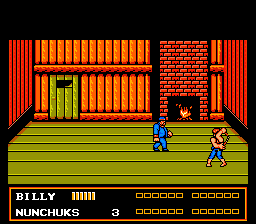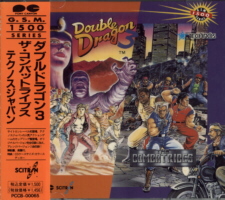Overview
 The NES version of Double Dragon III is considered by fans and critics to be the best.
The NES version of Double Dragon III is considered by fans and critics to be the best.Originally released for Japanese arcades in 1991, Double Dragon III: The Rosetta Stone - also known as Double Dragon III: The Sacred Stones - is the third game in the Double Dragon franchise. Developed by East Technology and published by Technos Japan Corp., Double Dragon III: The Rosetta Stone has since been released on a wide variety of platforms, with numerous differences between ports. Typically regarded as one of the worst games in the franchise, Double Dragon III: The Rosetta Stone is often criticized for its shop system, unnecessarily difficult bosses, and lowered graphical quality. Despite this, the NES version received mostly positive reviews, due to the more direct attention from Technōs Japan Corp.
The soundtrack for Double Dragon III: The Rosetta Stone was released in Japan on June 21, 1991. Distributed by Pony Canyon, the soundtrack for Double Dragon III is actually a compilation of Double Dragon III's soundtrack and The Combatribes soundtrack, with twelve tracks from the arcade version of Double Dragon III. Included on the soundtrack are several of the original songs, as well as some arranged versions of the songs.
 Double Dragon III / The Combatribes Soundtrack
Double Dragon III / The Combatribes Soundtrack- The Rosetta Stone
- The New Black Warriors
- Jim's Theme
- Li's Theme
- Ranzou's Theme
- Giuliano's Theme
- Enter the Dragon
- The Fearsome Goblin
- Awakening of the 2,000 Year Old Demon
- To the Children of the World
- Play Version
Gameplay
Arcade Version
 Hiruko, the fortune teller that the brothers meet.
Hiruko, the fortune teller that the brothers meet.Titled Double Dragon III: The Rosetta Stone in the arcade, this game once again follows Billy and Jimmy Lee, the series' stars. In this game, they are returning home after a vacation, and encounter a fortune teller, whose name is Hiruko. Hiruko tells them that they must fight a mysterious enemy stationed in Egypt, and in order to do so they must first collect all three of the Rosetta Stones. Thus, Billy and Jimmy set out on their quest to recover the three Rosetta Stones.
Similar to previous Double Dragon games, Double Dragon III: The Rosetta Stone is a side-scrolling 2D beat-em-up. Double Dragon III returns to the gameplay format established in the first Double Dragon. Rather than featuring the directional based attacks of Double Dragon II: The Revenge, Double Dragon III uses the punch and kick buttons that were used in the first game. Additionally, Double Dragon III removes many special moves, but adds its own, including a throwing move and a headbutt.
 The shop
The shopA new feature in Double Dragon III are weapon stores, where players can buy new power-ups and abilities for the characters. The thing that was heavily criticized about this feature was the fact that it cost actual credits in order to purchase these, requiring players to insert in more coins if they want to buy items, new playable characters, or improved abilities (agility, health, etc). The three extra character duos available in this mode are Urquidez, Chin, and Oyama (all three are pairs of brothers). In the Japanese version of the game, all of these things are available before purchasing them in the shop, as that feature is absent from the Japanese version.
NES Version
 Double Dragon III on the NES only gives players a single life.
Double Dragon III on the NES only gives players a single life.Double Dragon III: The Sacred Stones for the Nintendo Entertainment System was released in January of 1991 in North America by Acclaim Entertainment, February 22, 1991 in Japan, and was later published by Bandai in Europe. Very different from the arcade version of the game, Double Dragon III is similar to the other NES ports in the franchise. The plot is similar, but rather than searching for the Rosetta Stones, Billy and Jimmy are searching for the Sacred Stones in order to rescue Marian, who has been kidnapped again. Additionally, the final boss is no longer Cleopatra (in the arcade version), instead a possessed version of Marian named Queen Noiram.
Naturally, the game is incredibly difficult. The game only grants players a single life (although in cooperative play, each player has two lives). If the player manages to beat the entire game, beating the final boss will unlock two new characters, previously found in the arcade version of Double Dragon III. Beating the final boss unlocks the characters Chin Seimei and Yagyu Ranzou.
 Players can swap characters at any time.
Players can swap characters at any time.Another new feature of Double Dragon III involves special attacks and weapons. Not only does each character now have their own weapon that can be equipped from the sub menu (as well as using weapons dropped by enemies; this feature was in previous games), but when playing in cooperative mode, players can perform special attacks that every character participates in, such as headbutts and somersaults. Also relating to the cooperative mode, players can now switch available characters at any time, making it possible to switch characters when one player is getting low on health.
Other Versions
 Double Dragon III was ported to several computer systems, including the Amstrad CPC.
Double Dragon III was ported to several computer systems, including the Amstrad CPC.There were several other versions of Double Dragon III: The Rosetta Stone released, most of which were based on the arcade game. Two other home consoles received Double Dragon III: the Genesis port of the game was developed by Software Creations and is very similar to the arcade version, although the graphics are slightly improved. Additionally, the game was ported to the Game Boy as Double Dragon 3: The Arcade Game. Developed by Sales Curve, the game was criticized for its difficulty and, once again, the shop system (which was modified to allow two coins per level).
Like previous games in the franchise, Double Dragon III: The Rosetta Stone received a port of the game on a variety of computer systems, including the ZX Spectrum, Amstrad CPC, Commodore 64, Amiga, Atari ST, and PC. Developed by Sales Curve and published by Tradewest, these games were all modified versions of the arcade game, with lowered graphical quality and sound quality.
Trivia
- The opening story text of the NES version refers to Billy Lee as "Bimmy Lee."
Log in to comment